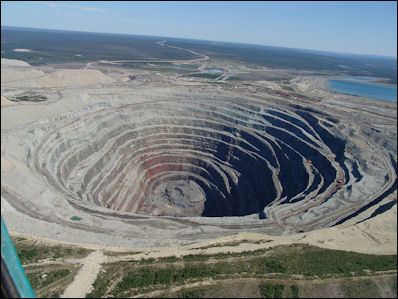DIAMONDS
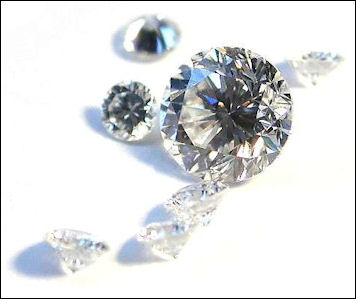
cut diamonds Diamonds are not the most valuable gems and are not th rarest ones either but they are certainly the most famous and widely sought after. The have found their way in to James Bond movies, Beatles songs and gangsta rappers teeth. In A.D. 1st century the Roman historian Pliny the Elder called diamonds the most "highly valued of human possessions." In the 1950s film Marilyn Monroe called them “a girl’s best friend.” [Sources: Andrew Cockburn, National Geographic, March 2002; Fred Ward, National Geographic, January 1979 ; George Switzer, National Geographic, December 1971 ╿ ; William Broad, New York Times, February 15, 1994; James Jackson, Time, March 4, 1996]
Tom Zoellner wrote in the Washington Post, “Diamonds, the ads say, are forever. Whether or not that's the case, diamond jewelry is a powerful symbol of status and love, and a $72 billion-a-year retail business worldwide. Diamonds can also be a key source of funding for violent conflicts in Africa. [Source: Tom Zoellner, Washington Post , July 4, 2010] Ironically, despite their high value, diamonds are made out of carbon, one of the most plentiful elements on earth, and the same stuff that pencil leads and coal are composed of. Like graphite, diamonds are 100 percent carbon. Anthracite coal, oil and wood are respectively 92 percent, 86 percent and 50 percent carbon. What makes a diamond a diamond as opposed to one of these other materials is the pressure they have been exposed to which has forces the carbon atoms to form extremely strong and stable bonds.
Diamonds are crystals — ordered arrays of atoms or molecules — of pure carbon. They are different from graphite which is made of carbon more loosely held together in sheets rather than crystals.
Diamonds aren’t as rare as many people think. About 35,000 kilograms of them were mined worldwide in 2006. They are deemed valuable because people regard them as valuable and supplies are carefully controlled so the market doesn’t collapse.
Websites and Resources on Gems: All About Gemstones allaboutgemstones.com ; Minerals and Gemstone Kingdom minerals.net ; International Gem Society gemsociety.org ; Wikipedia article Wikipedia ; Gemstones Guide gemstones-guide.com ; Gemological Institute of America gia.edu ; Mineralogy Database webmineral.com ;
Websites and Resources Diamonds: Info-Diamond info-diamond.com ; Diamond glossary and FAQ heart-in-diamond.com; Diamond Facts diamondfacts.org/about/index ; Diamond Mining and Geology khulsey.com/jewelry/kh_jewelry_diamond_mining ; Diamond Mine mining-technology.com/projects/de_beers ; Costellos.com costellos.com.au/diamonds ; DeeBeers debeers.com/page/home/ ; Wikipedia article Wikipedia ; American Museum of natural History amnh.org/exhibitions/diamonds ;
Book: “The Heartless Stone: A Journey Through the World of Diamonds, Deceit and Desire” by Tom Zoellner.
Gems and Birthstones

bourbon-colored diamond Most gems are crystals formed by the cooling of hot gases, solutions and melts deep inside the earth. When excited atoms lose energy from cooling they form a lattice, typical of crystals. The natural laws that create gems are the same as those that create snowflakes and salt, except that tremendous pressures and temperatures are needed. Diamonds can only form at depths of 100 miles or more below the earth's surface where pressures are a million pounds per square inch and temperatures are above 2,500̊F.╿
Gems are classified as precious, semiprecious and ornamental stones. The size and weight of many gem is measured in carats. Carat is an ancient term which denotes the uniform weight of a carob seed — 1/142 of an ounce, 1/5 of a gram, or 200 milligrams. The value of a gem is often determined more by the quality of the stone and lack of imperfections than by size. Cut is term that describes the quality as well as shape of a gem. A loupe is a one-eyed lenses used by jewelers to examines gems closely.
Ancient man wore different kinds of stones as ornaments and jewelry. There is evidence of trade of exotic stones in Europe as far back as 28,000 B.C. Historical record from India in 300 B.C. describe the mining of moonstones, sapphires, diamonds, emeralds, garnets and agates.
These days all gems are tampered with to some degree. Rubies and sapphires are heated to change their color. A clear topaz can be transformed into a blue one with a dose of radiation. And internal debris is removed from within diamonds with minuscule laser holes. It often very difficult for ordinary people to tell real gems from doctored ones from outright fakes. Glass and man-made zirconia are both passed of as rubies and sapphires.
Birthstones: 1) January: Garnet; 2) February: Amethyst; 3) March: Aquamarine; 4) April: Diamond; 5) May: Emerald; 6) June: Pearl of Alexandrine; 7) July: Ruby; 8) August: Peridot; 9) September: Sapphire; 10) October: Opal or Tourmaline; 11) November: Topaz; 12) December: Turquoise of Zircon.
Diamond Characteristics
Diamonds are so dense they reduce the speed of light by almost two thirds. They are cold to the touch because they absorb the heat from your fingers.
Diamonds don’t react chemically with any other substances. They are fully transparent in many wavelengths of light, are excellent electrical insulators and semiconductors, and can be engineered to hold an electrical charge.
But diamonds are not invulnerable. They will burn like coal and be reduced to carbon dioxide if burned with a blow torch. And even though diamonds are world's hardest material, they are also quite brittle and they will shatter like class if smacked hard enough with a hammer. In 1954 a 426.5 carat diamond was rescued at the last minute from the crushers at the Premier mine in South Africa. Raw diamonds have a smooth, soapy, texture. When reduced to dust, diamond are as black as coal.╿
Uses of Diamonds

diamond anvil
Diamonds have so many other uses that putting them on rings, earrings and necklaces seems like a waste. They are used in precision equipment, cutting tools for super hard materials such as marble and granite, optical equipment, hacksaw blades and lasers. Their lightness and stiffness makes them ideal for tweeter domes in stereo systems. Cosmetic and eye sturgeons rely on diamond blades and scalpels for unparalleled cutting and precision. In cataract surgery they are values because they cut without tearing. Scientists studying how things react to intense pressures places these things in a “diamond anvil cell” — a powerful vise with diamonds tips. Both dentists and roughnecks use drills that are coated with diamonds. They are part of machines that cut through pavement and concrete in highways and pick up sounds and images on a video and audio discs. Industrial diamonds are used for cutting and grinding in a wide range of machinery.
Since they have the greatest thermal conductivity of any material known, and don't burn up, diamond are incorporated into the world's most accurate thermometers and the highest capacity transmitters. These properties also make them an ideal material to place on the bottom of a Venus space probe which can withstand the cold vacuum of space and searing temperatures and immense atmospheric pressure on the surface of Venus.
Quality and Color of Diamonds
The value of a diamond is determined by the four C's: carat weight, cut, clarity and color. To examine a diamond properly you must look under a magnifying glass in a "north light." Hold a diamond next to white paper helps the color. Stones closest in color to the white paper are called ice and they are regarded as the best quality. Also See Gems Above
Carat, cut and color can be judges objectively but judging a diamond clarity requires an element of subjectivity. Clarity is important to value. Clarity ranges from flawless (no visible imperfections under a ten power loupe) to heavily flawed (defects visible with the naked eye). Experts can often disagree on the clarity of a stone. The best quality diamonds are said to have “brilliance,” “scintillation” and “fire.”
Colored diamonds, called "fancies," are created by impurities. Nitrogen, for example, results in yellow stones and boron produces blue stones. Radiation causes them to turn green. Other colors include orange, green, brown and pink. Red and purple stone are the rarest and most expensive. Diamonds designated as pigeon-blood red (only a half dozen or so are known to exist) are worth up to $1 million a carat (compared to $15,000 a carat for a flawless white diamond). Blues and pinks are also very valuable. They sometimes are sold for hundreds of thousands of dollars a carat).
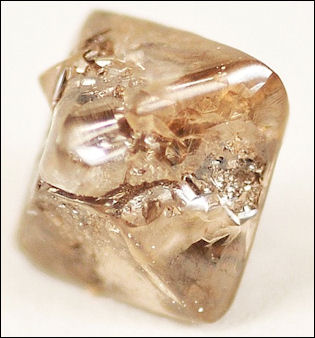
Pink, blue, champagne, mocha and brown diamonds are rarer and more expensive than white diamonds. Traditionally, though, the most valued diamonds were white and translucent. Stones with color were regarded as impure and inferior. The market for colored stones was created by Australia's giant Argyle mine, which had consistently produced the most diamonds in the world in terms of volume but earned less money that other mines because it stones were deemed poor quality. Little could be done about its small diamonds but something could be done about its large supplies of colored stones. The "brown" and "yellow" stones were renamed "cognac" and "champagne" and featured in glossy advertising spreads with beautiful models. Before long diamonds that were once relegated to industrial use were a $200 million a year market.
Carbonado diamonds, also called black diamonds, are opaque black or gray diamond that have a porous, charcoal-like texture. They are found only in Brazil and Central African Republic and appear to have originated from outer space, perhaps from a giant asteroid that struck the earth three billion years ago.
Book: :Collecting and Classifying Colored Diamonds: An Illustrated Study of the Aurora Collection” by Dr. George Harlow (Ashland Press, New York, 1998).
Rarity and Value of Diamonds
The Economist reported: “The rewards for digging carbon out of the ground differ wildly. A tonne of coal fetches around $120. A diamond for the same price would be so small you’d probably never find it in the first place.
“On the rarity and value of diamonds, Tom Zoellner wrote in the Washington Post,”Although you won't stumble across a diamond while digging in your tomato garden, they are far more common than their cost suggests. The big gem companies aggressively control the supply that arrives at market, creating artificial scarcity and high prices. [Source: Tom Zoellner, Washington Post , July 4, 2010]
This practice was born in the diamond fields of South Africa in the 1880s, when Cecil Rhodes, the chairman of De Beers Consolidated Mines, discovered that he could inflate prices at will simply by locking up the rights to every diamond mine he could find. His successor, Ernest Oppenheimer, developed a complex network of wholesalers that gave De Beers effective control of up to 90 percent of the world's rough-diamond trade through most of the 20th century, as the company hoarded stones in basement vaults and doled them out strategically.
Four Cs
Tom Zoellner wrote in the Washington Post, “This handy mnemonic — color, cut, clarity and carat — was developed in the 1940s by the Gemological Institute of America, still the world's premier diamond-grading company. Lore holds that every diamond is unique and a work of nature's art. But this idea was intimidating to American customers who wanted a firm readout of a diamond's worth before buying it. De Beers therefore loved the Four Cs, and the company sent speakers on a promotional tour to explain these standards as if they had been observed for centuries. [Source: Tom Zoellner, Washington Post , July 4, 2010] But when it comes to the most popular kind of diamond — the round, brilliant-cut stone that is a staple of engagement solitaires — a key factor embedded in the cut rating is likely to have a big impact on value. The "depth percentage," the relationship between the stone's top and the angle of its slanted sides, can make a diamond's glitter a little more spectacular thanks to the physics of light. The sweet spot? A ratio of 58 to 60 percent. Too many buyers of stones of less than two carats get hung up on minor gradients of color and clarity, which are invisible to the naked eye and meaningful only at the cash register.
“For those who don't plan to routinely ogle their stone under a microscope, an easier formulation would be the Two S's: size and sparkle. The resale value of a diamond drops between 30 and 50 percent the moment you walk out of the store with it (a sixth myth is that they are good investments; they aren't) so you might as well enjoy its illusory light while you can.
Diamonds, Love and Power
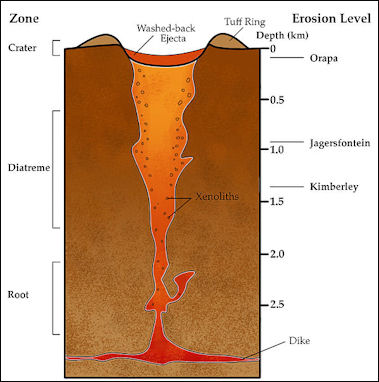
Volcanic pipe Tom Zoellner wrote in the Washington Post, “The tradition of the diamond engagement ring was largely concocted in the 1930s by De Beers's ad agency N.W. Ayer & Son — the same Madison Avenue shop that would later craft the wildly successful slogan "A diamond is forever." Through magazine advertisements and Hollywood product placements, American customers were sold the idea that even a man of modest means must give a diamond to his betrothed, just as kings and aristocrats had done in several examples cherry-picked from European folklore. [Source: Tom Zoellner, Washington Post , July 4, 2010]
In fact, diamonds historically served as tokens of statist privilege more than anything so frilly and ordinary as love. De Beers's appeal to royal fantasies (and, more subtly, male fears of inadequacy) nonetheless caught the American public's imagination, as did the notion that a groom is supposed to spend two months of his salary on a rock. This, too, was an invented custom. It was also flexible: In ad blitzes elsewhere, British customers were told to spend one month's salary, while the Japanese were told to spend three.
Diamond Formation
Diamonds are believed to be among the oldest minerals on earth. Scientists believe that most of them were formed about 3.5 billion years ago when the earth was made up largely of volcanos and the atmosphere was mostly a mixture of carbon dioxide and sulphur dioxide.
In 2007, German scientists at the Westfllische Wilhelms Universitat announced they had found the world’s oldest diamonds: 4.25-billion-year-old minerals, 700 million years older than the previous oldest known diamonds, found encased in zirconia silicate in the 80-kilometer-long Jack Hills rock formation near the west cost of Australia.
Diamonds were formed in the upper mantel of the earth's core under enormous heat and pressure that crystallized the carbon into solid cubic patterns, giving them their unsurpassed hardness. Diamonds can only form at depths of 150 miles below the earth's surface where pressures are a million pounds per square inch and temperatures are above 2,500̊F. Many diamonds have remained unchanged since their formation 3.5 billion years ago. Geologist believe that diamonds are still being formed deep in the earth but are far too deep to reach. ╿
Pipes and Kimberlites
Scientists have long understood how diamonds are made. What they find puzzling is how and why diamonds rise from deep inside the earth to particular places on the surface. In most cases, diamonds have been pushed to the earth's surface by very unusual, volcanic shaft of metamorphosed lava, known as pipe.
Pipes are super long and deep. The material found in them originates from far greater depths inside the earth than any other known volcanic rock. In contrast to shafts of conventional volcanos, which may extend into the earth 50 miles or so, the volcanic pipes that pick up diamonds may be as much as 300 miles deep. They also tend to be very narrow — a few meters across in some places.
mining the Udachnaya pipe No human has ever witnessed a diamond eruption. Still, evidence suggests that the process is explosive and rise fast to the surface and is nothing like the gentle gurgling of some contemporary volcanoes. The tops of many diamond pipes are craters rather than cones, which suggests an explosive event. Experts believe that the overall journey from the earth's interior takes hours, not days or months as is the case with magma and lava from a volcano.
Diamond bearing rock is called kimberlite "after material from a pipe first found and identified at Kimberly, South Africa in 1971. Pipes are often shaped like carrots with the top sticking from the surface. The youngest pipes are aged 45 million years, and the oldest ones go back some 2.6 million years. They have often been weathered by rain and wind and the diamonds have washed away in gravel.
Kimberlite pipes are like solidified volcano vents, bursting from earth’s core through fissures in granite rock. Some of them passed through ancient diamond-bearing, 3 billion-year-old beds of rock, pushing them up to the surface. There are thousands of kimberlite pipes but only a handful have diamonds. The last known eruption of kimberlite to the surface of the earth occurred 47 million years ago.
Rivers, runoff and glaciers can transport diamond-bearing rock from kimberlites hundreds of kilometers away for their sources. Often the job of geologists to find this source .
History of Diamonds
In the A.D. first century, Romans used diamonds to carve cameos. Despite Pliny the Elder’s claim that diamonds the most "highly valued of human possessions” diamonds were not well known until the A.D. 3rd century and not considered particularly valuable until the 17th century. The word diamond comes from the ancient Greek word “adamas”, meaning “invincible.”
Early diamonds were extracted mainly from streams. No one knows exactly when man began collecting diamonds. It may have been as early at 800 B.C. around Golconda, India. Through much of human they were considered no more valuable than other gem like topazes and garnets except they were harder to find.
Before diamonds were discovered in South Africa, many of the world diamonds came from India. Diamonds have been mined in India for more than 2,000 years. The diamond and gold mines of Bihar and Golconda were the most famous. Indians systematically organized alluvial digs in Golconda until the early 1700's." Diamond tipped tools were common during this period and jade cutting knives were exported to China. This mines were depleted by the 18th century but not before they produced the Hope and Orloff diamonds as well as the Koh-i-noor, Shah and Great Mogul, all of which were owned by the builder of the Taj Mahal, Shah Jahan.
In 1786, the chemist Smithson Tennant discovered that diamonds are made of carbon.
DeBeers launched its “Diamond is Forever” slogan in 1948. Some regard it as the most successful advertising campaign ever. Before the campaign the idea of giving a diamond engagement ring didn’t exist
NASA is checking out other planets for diamonds and other minerals.
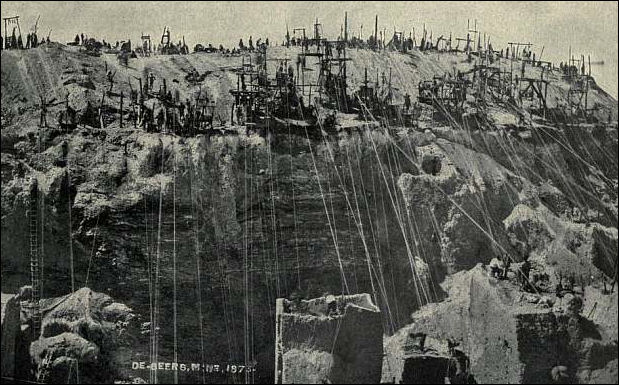
South African diamond mine
Diamonds in South Africa
In 1866 an unusual pebble was found near Kimberly on the banks of the Orange River in South Africa It was a 21-carat diamond. Later named Eureka, it was found some school children between some rocks on a farm near Hopestown.Three years later an 83-carat stone was found and the largest diamond rush in history was on. [Source: Fred Ward, National Geographic, January 1979 []
Diamonds were discovered in Kimberley in 1871 on a farm owned by a family named DeBeers. At first thousands of individual diggers worked claims of 31 square feet with a shovel and bucket. In the chaos deaths occurred from fights and collapsed walls. As time went on the claims became consolidated and after two decades two men owned all of South Africa's mines: the reserved colonialist Cecil Rhodes and the flamboyant Barney Barnato, a former actor and boxer from London’s East End.
In 1874 the average "digger" earned the hefty sum of $200 a week. His only expenses were $130 for equipment and $40 to pay eight Zulu warriors to do the digging. Only licensed diggers or claim holders could sell diamond, and any blacks found with diamonds were assumed to be thieves.
In 1888 Rhodes outmaneuver Barnato and bought him out with the largest check ever written up until that time — £5,338,650 (about US$400,000,000 today). Rhodes named his new company De Beers, after the family who owned the farm where two mines were located. In the 1920s the company expanded under the stewardship of Ernest Oppenheimer, a former clerk in the company’s London office, and money provided by American financing. Today the Oppenheimer family still largely controls De Beers, a company which still largely controls the world's diamond market.
Image Sources: Wikimedia Commons
Text Sources: New York Times, Washington Post, Los Angeles Times, Times of London, The Guardian, National Geographic, The New Yorker, Time, Newsweek, Reuters, AP, AFP, Wall Street Journal, The Atlantic Monthly, The Economist, Global Viewpoint (Christian Science Monitor), Foreign Policy, Wikipedia, BBC, CNN, NBC News, Fox News and various books and other publications.
Last updated December 2023

